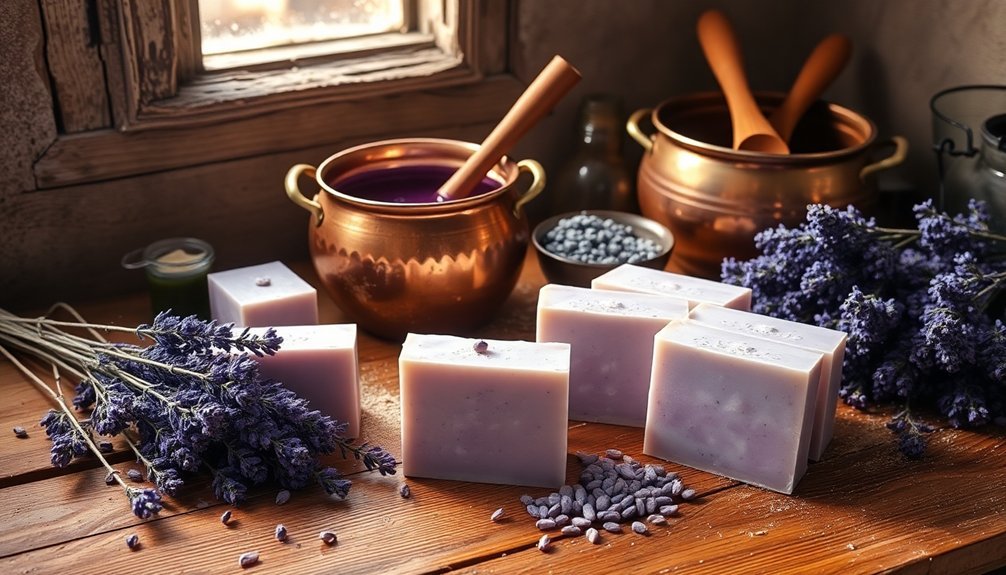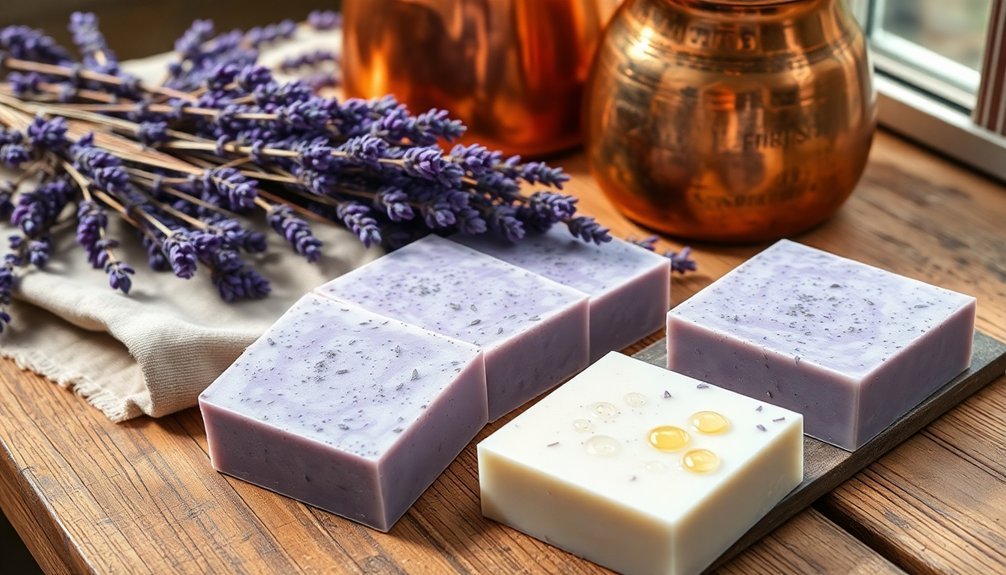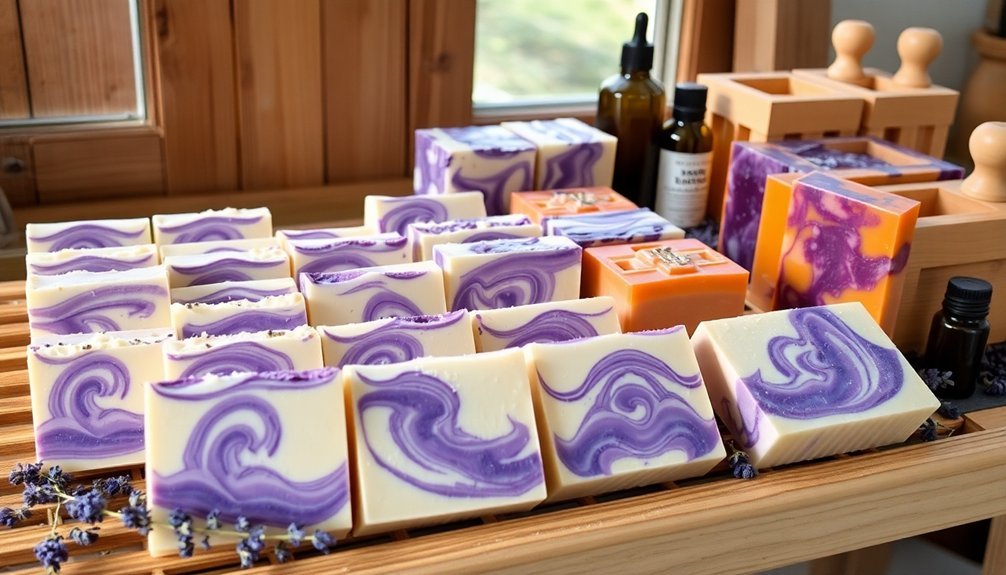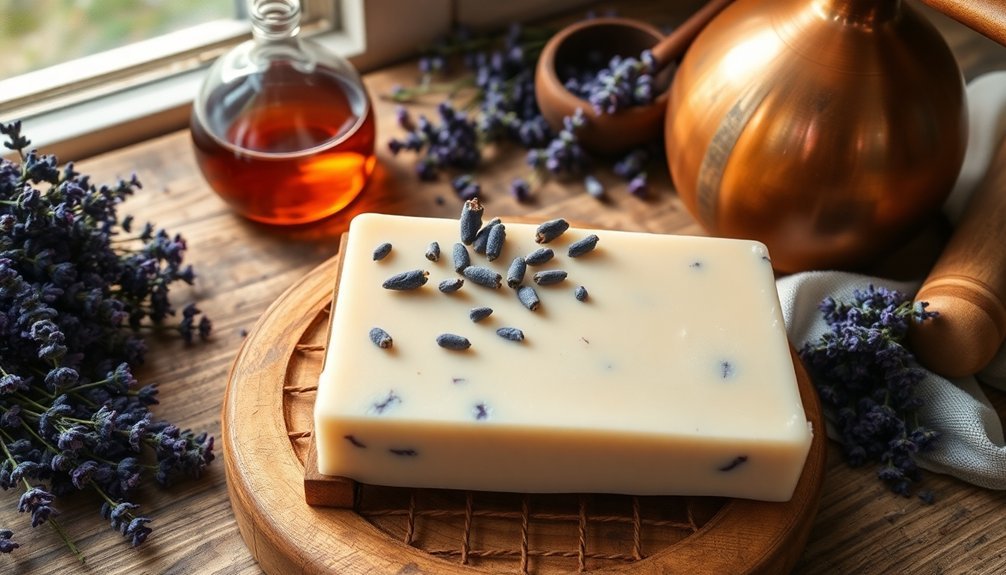Traditional lavender soap crafting relies on the cold process method, which preserves the flower's therapeutic properties. You'll need quality lavender—preferably Lavandula angustifolia or intermedia—and patience for the four-week curing period that guarantees complete saponification. This time-tested technique yields bars that soothe skin irritations while providing aromatherapy benefits. Natural colorants like spirulina or beetroot enhance visual appeal without compromising purity. These centuries-old methods reveal why artisan lavender soap remains a cherished skincare treasure.
The Ancient Art of Soap Making: A Lavender Legacy

While modern soaps fill store shelves with synthetic ingredients and artificial fragrances, the ancient art of soap making continues to thrive through traditional methods that have stood the test of time.
Dating back thousands of years, these techniques are preserved today in the meticulous crafting of lavender essential oil soaps.
When you purchase artisan soap made through the cold process method, you're connecting with a heritage that prioritizes quality over mass production.
Skilled craftspeople blend olive and coconut oils with pure lavender essential oil, allowing the natural therapeutic properties to remain intact.
This time-honored approach yields bars that soothe skin irritations while promoting relaxation—benefits recognized for centuries.
The four-week curing period guarantees each bar reaches ideal mildness, demonstrating the patience inherent in this enduring craft.
Sourcing Quality Lavender for Authentic Scenting

When you're creating traditional lavender soap, the cultivation practices greatly impact the final fragrance, with hand-harvested flowers yielding the most potent essential oils.
You'll notice distinct differences in lavender oils from Provence versus California coastal varieties, each bringing unique aromatic profiles to your soap creations.
Choosing sustainable, locally-grown lavender not only supports regional farmers but guarantees you're capturing the authentic therapeutic benefits that have made lavender soaps cherished for centuries.
Lavender Cultivation Practices
The foundation of exceptional traditional lavender soap begins with meticulously sourced lavender flowers.
To guarantee the highest quality essential oil for your soaps, you'll want to understand how proper cultivation affects the final product.
Lavender thrives in well-drained, sandy soils with a pH between 6.5 and 7.5. For soap-making specifically, look for Lavandula angustifolia or Lavandula x intermedia varieties, which offer superior oil content and fragrance profiles.
- Harvest in the morning when essential oils are most concentrated
- Choose mid to late summer during peak bloom for peak harvesting
- Dry flowers promptly after cutting to preserve aromatic qualities
- Implement sustainable farming practices like crop rotation
- Use natural pest control methods to maintain environmental integrity
These sustainable farming practices not only yield superior lavender but also guarantee the long-term health of cultivation sites.
Regional Oil Variations
Beyond cultivation practices, the geographic origin of your lavender greatly shapes the character of traditional soap. Provence, France stands as the gold standard, with its unique climate and soil creating lavender essential oil with unparalleled depth and complexity.
Artisan soap makers understand that regional variations matter greatly. English lavender delivers a sweet, floral profile, while French varieties offer sharper, more herbaceous notes. These differences allow crafters to customize their scent profiles for specific therapeutic or aromatic goals.
The best soap makers prioritize relationships with sustainable, local farms where possible, ensuring freshly harvested plants yield more potent oils. The distillation method—predominantly steam distillation—varies between regions, further influencing the essential oil's character.
Cold Process vs. Hot Process: Preserving Lavender's Essence

When crafting lavender soap, you'll find that cold process methods keep the temperature-sensitive essential oils intact, preserving their therapeutic benefits that would otherwise evaporate at high temperatures.
The longer curing time of cold process soaps—at least four weeks—allows lavender's soothing and anti-inflammatory properties to fully develop in your finished bars.
Your handcrafted cold process lavender soap will maintain pure lavender essence with its traditional creamy lather, unlike hot process techniques that might alter the flower's natural chemical composition.
Temperature-Sensitive Essential Oils
Although both methods create beautiful soap, cold process techniques provide superior preservation of lavender's delicate properties.
When you're working with temperature-sensitive lavender essential oils, cold process soap making prevents the thermal degradation that would otherwise diminish their therapeutic benefits and subtle aromatic notes.
Your handcrafted soap benefits from this gentler approach in several ways:
- Preserves the full spectrum of lavender's calming and antiseptic properties
- Maintains the oil's natural fragrance profile without chemical alterations
- Allows for a slower, more complete integration of oils during the 4-6 week cure
- Retains more natural glycerin, enhancing lavender's soothing effects on sensitive skin
- Creates a rich, creamy lather that delivers lavender's benefits directly to your skin
Longer Curing Benefits
The investment of time in cold process soap making yields rewards that simply can't be rushed. When you choose a lavender artisan soap that's been properly cured for 4-6 weeks, you're getting more than just a cleansing product—you're embracing a gentle, pH-balanced creation that makes your skin look healthy and nourished.
| Feature | Cold Process | Hot Process |
|---|---|---|
| Fragrance Retention | Preserves delicate lavender scent | Heat diminishes essential oil properties |
| Glycerin Content | Naturally retained | Often reduced |
| Skin Compatibility | Gentler for sensitive skin | Typically more alkaline |
The longer curing time allows natural glycerin to work its magic while creating a milder soap. Each batch showcases unique variations—testament to traditional techniques that prioritize quality over quick production.
Pure Lavender Preservation
Capturing lavender's essence in soap requires more than just adding fragrance—it demands a method that respects the plant's delicate properties.
Cold process soap making stands out as the superior technique for preserving lavender's natural properties. Unlike hot processing, which heats away therapeutic benefits, cold processing maintains the integrity of this precious herb.
You'll appreciate how cold process techniques:
- Preserve lavender's therapeutic qualities by avoiding high temperatures
- Allow for a 4-6 week curing period, enhancing mildness and longevity
- Enable the integration of high-quality ingredients like aloe vera and coconut oil
- Create distinctive textures and appearances unique to artisanal production
- Maintain the subtle, natural scent profile that hot process often diminishes
This traditional approach guarantees you're getting the full aromatic and healing benefits that genuine lavender offers.
Essential Oils, Buds, and Infusions: Lavender Integration Methods

Integrating lavender into traditional soap requires careful consideration of multiple techniques, each offering distinct benefits to the final product.
When you're crafting artisan soaps, you'll find that lavender essential oil provides powerful therapeutic properties that combat acne, inflammation, and wrinkles while promoting relaxation.
You can enhance your soap's sensory appeal by incorporating lavender buds, which offer gentle exfoliation and amplify the natural fragrance.
Traditional cold process methods are ideal for preserving lavender's beneficial qualities, as the several-week curing period allows essential oils to fully integrate into the soap base.
For visual appeal, consider strategically placing dried lavender flowers throughout your soap, creating a distinctive aesthetic that honors lavender's centuries-old significance in hygiene practices.
Each integration method contributes unique elements to your finished creation.
Curing and Aging: Enhancing Lavender's Aromatic Profile

After you've poured your lavender soap into molds and allowed it to set, proper curing becomes vital for developing its full aromatic potential.
Traditional artisan techniques recommend aging lavender soap for at least four weeks, ensuring complete saponification and developing a milder bar that's gentle on sensitive skin.
During this important period, you'll notice significant improvements as moisture evaporates and your soap hardens.
This patient curing process transforms your creation in multiple ways:
- Enhances the lavender's scent profile, creating richer, more complex aromas
- Creates a firmer texture for longer-lasting bars
- Improves lathering qualities for a luxurious cleansing experience
- Allows ingredients to fully saponify, ensuring skin safety
- Preserves lavender's gentle properties, ideal for sensitive skin
Patience with curing rewards you with superior lavender soap that continues improving with time.
Natural Colorants to Complement Lavender Soap Aesthetics
While your lavender soap cures to perfection, you can focus on its visual presentation through natural colorants. Beetroot powder, spirulina, and turmeric offer stunning hues that enhance your artisan soap while maintaining eco-friendly integrity.
These plant-based additions do more than please the eye—they align with consumer demand for organic, cruelty-free products. You'll find natural colorants are gentler on skin and complement lavender's soothing properties, making them ideal for sensitive skin formulations.
Each colorant brings additional benefits: spirulina's antioxidant properties and turmeric's anti-inflammatory effects enrich the lavender experience. The unique patterns they create guarantee no two bars are identical, highlighting your soap's artisan quality.
Therapeutic Benefits of Traditional Lavender Soap Formulations
Traditional lavender soap offers far more than a pleasant scent; it delivers a wealth of therapeutic benefits that have stood the test of time.
You'll find these artisan-crafted soaps combine lavender oil with nourishing ingredients like aloe vera and coconut oil, creating a powerhouse of skin care benefits.
The cold process method preserves these therapeutic benefits, ensuring you receive maximum value from each use:
- Soothes inflammation and treats acne through lavender's natural antibacterial properties
- Moisturizes sensitive skin with rich coconut oil and aloe vera
- Reduces the appearance of fine lines and wrinkles
- Promotes relaxation and stress relief through aromatherapy
- Provides a creamy, luxurious lather that cleanses without stripping natural oils
When you choose traditional lavender soap, you're embracing centuries of natural skincare wisdom.
Frequently Asked Questions
Why Is Artisan Soap so Expensive?
You're paying for quality ingredients, handcrafted small batches, longer production times, complex essential oil scents, and ethical sourcing practices. These factors all contribute to artisan soap's higher price point.
Why Does My Lavender Soap Turn Brown?
Your lavender soap turns brown because natural oils oxidize when exposed to air and light. Heat can accelerate this process, and certain ingredients like olive oil or lavender essential oil naturally darken over time.
How Long Does Artisan Soap Last?
Your artisan soap can last 3-12 months with proper care. You'll extend its life by keeping it dry between uses and storing it in a well-ventilated area. Don't let it sit in water!
What Makes a Soap Artisan?
You're an artisan soapmaker when you craft small batches by hand, use high-quality natural ingredients, employ traditional methods like cold process, create unique products, and often prioritize sustainability in your production practices.
In Summary
When you craft traditional lavender soap using age-old methods, you're not just making cleanser—you're preserving heritage. You'll find the extra time spent sourcing quality lavender, mastering cold process techniques, and patiently curing your creations yields exceptional results. Your skin will thank you for these therapeutic bars, while your senses will delight in authentic lavender's calming embrace. It's an artisan tradition worth carrying forward.





Leave a Reply